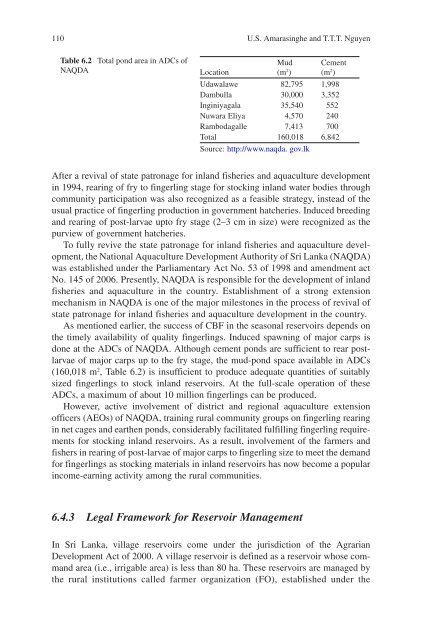Success Stories In Asian Aquaculture - Library - Network of ...
Success Stories In Asian Aquaculture - Library - Network of ...
Success Stories In Asian Aquaculture - Library - Network of ...
- No tags were found...
You also want an ePaper? Increase the reach of your titles
YUMPU automatically turns print PDFs into web optimized ePapers that Google loves.
110 U.S. Amarasinghe and T.T.T. NguyenTable 6.2 Total pond area in ADCs <strong>of</strong>NAQDALocationMud(m 2 )Cement(m 2 )Udawalawe 82,795 1,998Dambulla 30,000 3,352<strong>In</strong>giniyagala 35,540 552Nuwara Eliya 4,570 240Rambodagalle 7,413 700Total 160,018 6,842Source: http://www.naqda. gov.lkAfter a revival <strong>of</strong> state patronage for inland fisheries and aquaculture developmentin 1994, rearing <strong>of</strong> fry to fingerling stage for stocking inland water bodies throughcommunity participation was also recognized as a feasible strategy, instead <strong>of</strong> theusual practice <strong>of</strong> fingerling production in government hatcheries. <strong>In</strong>duced breedingand rearing <strong>of</strong> post-larvae upto fry stage (2–3 cm in size) were recognized as thepurview <strong>of</strong> government hatcheries.To fully revive the state patronage for inland fisheries and aquaculture development,the National <strong>Aquaculture</strong> Development Authority <strong>of</strong> Sri Lanka (NAQDA)was established under the Parliamentary Act No. 53 <strong>of</strong> 1998 and amendment actNo. 145 <strong>of</strong> 2006. Presently, NAQDA is responsible for the development <strong>of</strong> inlandfisheries and aquaculture in the country. Establishment <strong>of</strong> a strong extensionmechanism in NAQDA is one <strong>of</strong> the major milestones in the process <strong>of</strong> revival <strong>of</strong>state patronage for inland fisheries and aquaculture development in the country.As mentioned earlier, the success <strong>of</strong> CBF in the seasonal reservoirs depends onthe timely availability <strong>of</strong> quality fingerlings. <strong>In</strong>duced spawning <strong>of</strong> major carps isdone at the ADCs <strong>of</strong> NAQDA. Although cement ponds are sufficient to rear postlarvae<strong>of</strong> major carps up to the fry stage, the mud-pond space available in ADCs(160,018 m 2 , Table 6.2 ) is insufficient to produce adequate quantities <strong>of</strong> suitablysized fingerlings to stock inland reservoirs. At the full-scale operation <strong>of</strong> theseADCs, a maximum <strong>of</strong> about 10 million fingerlings can be produced.However, active involvement <strong>of</strong> district and regional aquaculture extension<strong>of</strong>ficers (AEOs) <strong>of</strong> NAQDA, training rural community groups on fingerling rearingin net cages and earthen ponds, considerably facilitated fulfilling fingerling requirementsfor stocking inland reservoirs. As a result, involvement <strong>of</strong> the farmers andfishers in rearing <strong>of</strong> post-larvae <strong>of</strong> major carps to fingerling size to meet the demandfor fingerlings as stocking materials in inland reservoirs has now become a popularincome-earning activity among the rural communities.6.4.3 Legal Framework for Reservoir Management<strong>In</strong> Sri Lanka, village reservoirs come under the jurisdiction <strong>of</strong> the AgrarianDevelopment Act <strong>of</strong> 2000. A village reservoir is defined as a reservoir whose commandarea (i.e., irrigable area) is less than 80 ha. These reservoirs are managed bythe rural institutions called farmer organization (FO), established under the
















